Fabrications of Fully Transparent Gallium Oxide Solar-Blind Photodetectors
Abstract
1. Introduction
2. Materials and Methods
3. Results and Discussion
4. Conclusions
Author Contributions
Funding
Data Availability Statement
Conflicts of Interest
References
- Pandey, S.; Ganguly, S.; Shukla, A.; Tripathi, A. Enhanced UV Photodetector Efficiency with a ZnO/Ga2O3 Heterojunction. ACS Appl. Electron. Mater. 2025, 7, 1173–1181. [Google Scholar] [CrossRef]
- Pintor-Monroy, M.I.; Murillo-Borjas, B.L.; Quevedo-Lopez, M.A. Nanocrystalline and polycrystalline β-Ga2O3 thin films for deep ultraviolet detectors. ACS Appl. Electron. Mater. 2020, 2, 3358–3365. [Google Scholar] [CrossRef]
- Kaushik, S.; Naik, T.R.; Alka, A.; Garg, M.; Tak, B.R.; Ravikanth, M.; Rao, V.R.; Singh, R. Surface modification of AlN using organic molecular layer for improved deep UV photodetector performance. ACS Appl. Electron. Mater. 2020, 2, 739–746. [Google Scholar] [CrossRef]
- Cai, Q.; You, H.; Guo, H.; Wang, J.; Liu, B.; Xie, Z.; Chen, D.; Lu, H.; Zheng, Y.; Zhang, R. Progress on AlGaN-based solar-blind ultraviolet photodetectors and focal plane arrays. Light Sci. Appl. 2021, 10, 94. [Google Scholar] [CrossRef] [PubMed]
- Zhu, Y.; Liu, K.; Ai, Q.; Hou, Q.; Chen, X.; Zhang, Z.; Xie, X.; Li, B.; Shen, D. A high performance self-powered ultraviolet photodetector based on a p-GaN/n-ZnMgO heterojunction. J. Mater. Chem. C 2020, 8, 2719–2724. [Google Scholar] [CrossRef]
- Cheng, L.; Wu, Y.; Cai, W.; Zheng, W. Diamond immersion photodetector for 213 nm deep-ultraviolet photodetection. Mater. Today Phys. 2023, 36, 101164. [Google Scholar] [CrossRef]
- Drewelow, G.; Reed, A.; Stone, C.; Roh, K.; Jiang, Z.T.; Truc, L.N.T.; No, K.; Park, H.; Lee, S. Work function investigations of Al-doped ZnO for band-alignment in electronic and optoelectronic applications. Appl. Surf. Sci. 2019, 484, 990–998. [Google Scholar] [CrossRef]
- Wang, J.; Ran, Q.; Xu, X.; Zhu, B.; Zhang, W. Preparation and optical properties of TiO2-SiO2 thin films by sol-gel dipping method. In IOP Conference Series: Earth and Environmental Science; IOP Publishing: Bristol, UK, 2019. [Google Scholar]
- Wang, S.; Zhou, X.; Zhang, Y.; Liu, H.; Xie, C. Flexible, transparent and self-powered deep ultraviolet photodetector based on Ag NWs/amorphous gallium oxide Schottky junction for wearable devices. Sens. Actuators A Phys. 2021, 330, 112870. [Google Scholar] [CrossRef]
- Higuchi, K.; Nishinaka, H.; Kimura, K.; Tanaka, T.; Aoki, T.; Inoue, M. Electron-Beam-Induced Crystallization of Amorphous Gallium Oxide Thin Films Using Scanning Transmission Electron Microscopy. Cryst. Growth Des. 2025, 25, 3749–3755. [Google Scholar] [CrossRef]
- Ponja, S.D.; Krishna, M.G.; Bhatt, R.; Kulkarni, S.D. Highly conductive and transparent gallium doped zinc oxide thin films via chemical vapor deposition. Sci. Rep. 2020, 10, 638. [Google Scholar] [CrossRef] [PubMed]
- Oh, S.; Kim, C.-K.; Kim, J. High responsivity β-Ga2O3 metal–semiconductor–metal solar-blind photodetectors with ultraviolet transparent graphene electrodes. ACS Photonics 2017, 5, 1123–1128. [Google Scholar] [CrossRef]
- Huang, Z.; Guo, J.; Li, Y.; Liu, S.; Zhang, Q.; Wang, Q.; Guo, D. Fully transparent amorphous Ga2O3-based solar-blind ultraviolet photodetector with graphitic carbon electrodes. Crystals 2022, 12, 1427. [Google Scholar] [CrossRef]
- Chen, M.; Zhao, C.; Lin, Y.; Wang, H.; Zheng, W.; Guo, D.; Wu, Z.; Li, P.; Sun, C. Zero-biased deep ultraviolet photodetectors based on graphene/cleaved (100) Ga2O3 heterojunction. Opt. Express 2019, 27, 8717–8726. [Google Scholar] [CrossRef] [PubMed]
- Zhou, S.; Wang, Y.; Li, C.; Zhang, Q.; Sun, H.; Jiang, M.; Guo, D. Fully Transparent and High-Performance ε-Ga2O3 Photodetector Arrays for Solar-Blind Imaging and Deep-Ultraviolet Communication. Adv. Photonics Res. 2022, 3, 2200192. [Google Scholar] [CrossRef]
- Zhang, C.; Liu, X.; Yu, X.; Yang, T.; Guo, D. High-performance fully transparent Ga2O3 solar-blind UV photodetector with the embedded indium–tin–oxide electrodes. Mater. Today Phys. 2023, 33, 101034. [Google Scholar] [CrossRef]
- Lu, Y.; Yang, T.; Li, P.; Guo, D.; Zhou, H.; Zhai, T. Ultrasensitive flexible κ-phase Ga2O3 solar-blind photodetector. ACS Appl. Mater. Interfaces 2022, 14, 34844–34854. [Google Scholar] [CrossRef] [PubMed]
- Wu, C.; Zhang, X.; Xu, Y.; Wang, F.; Guo, D.; Li, P. Self-healing wearable self-powered deep ultraviolet photodetectors based on Ga2O3. J. Semicond. 2023, 44, 072807. [Google Scholar] [CrossRef]
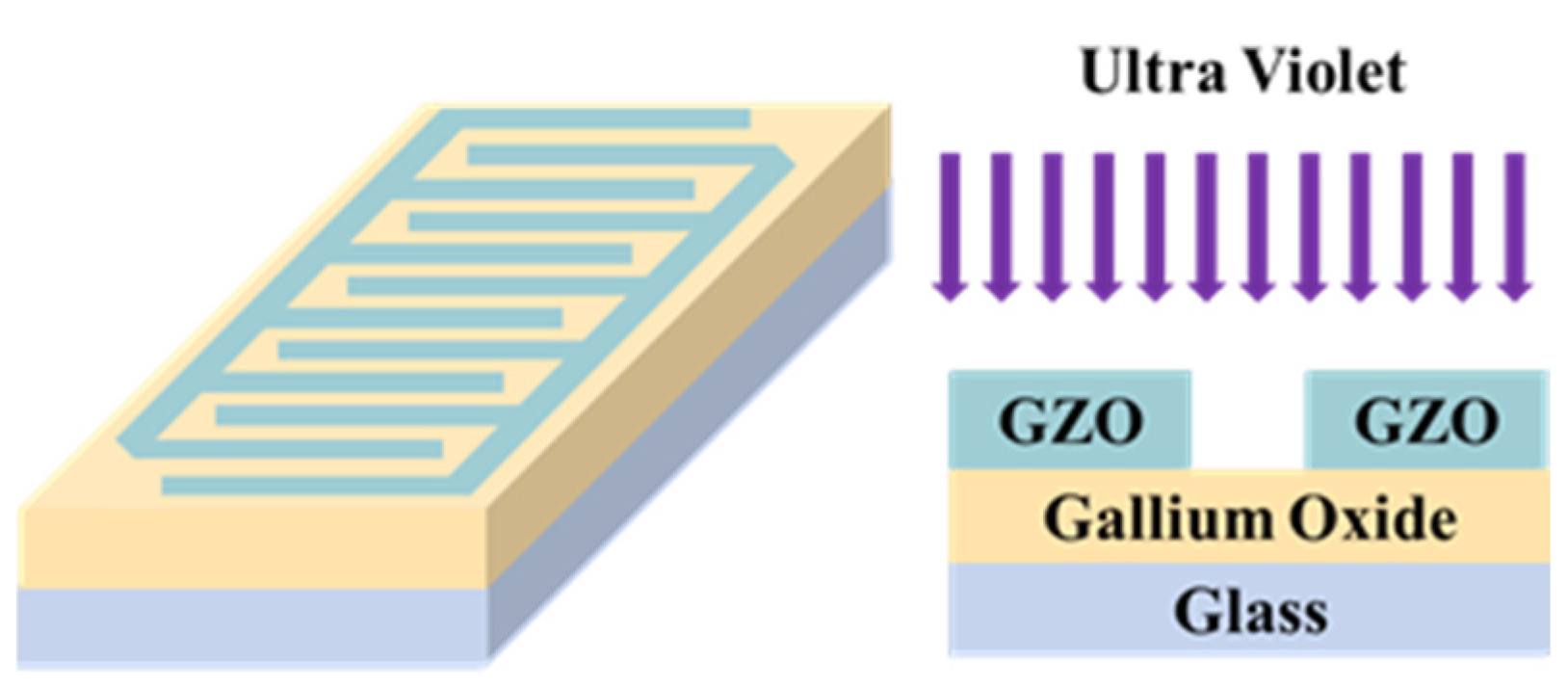
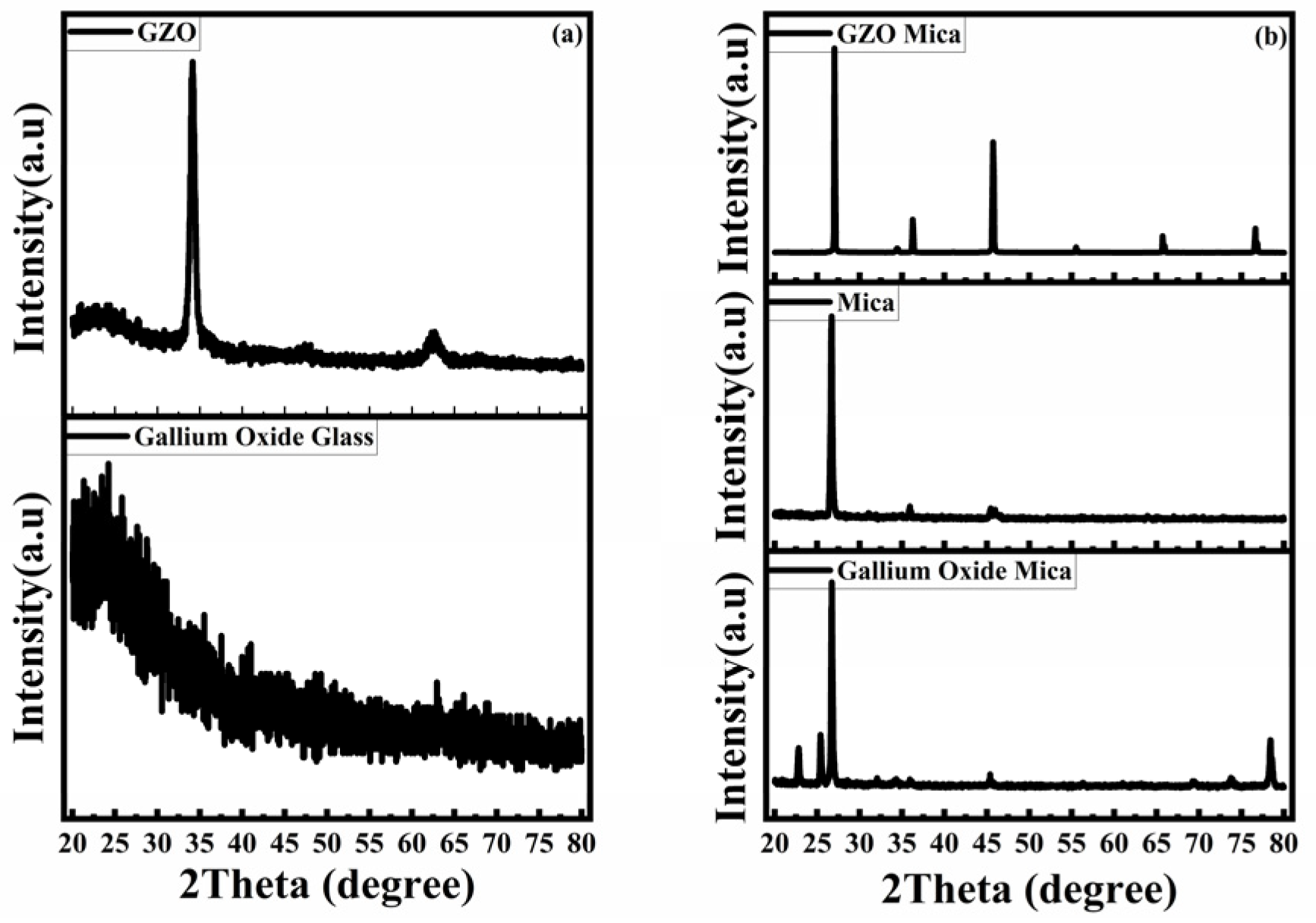
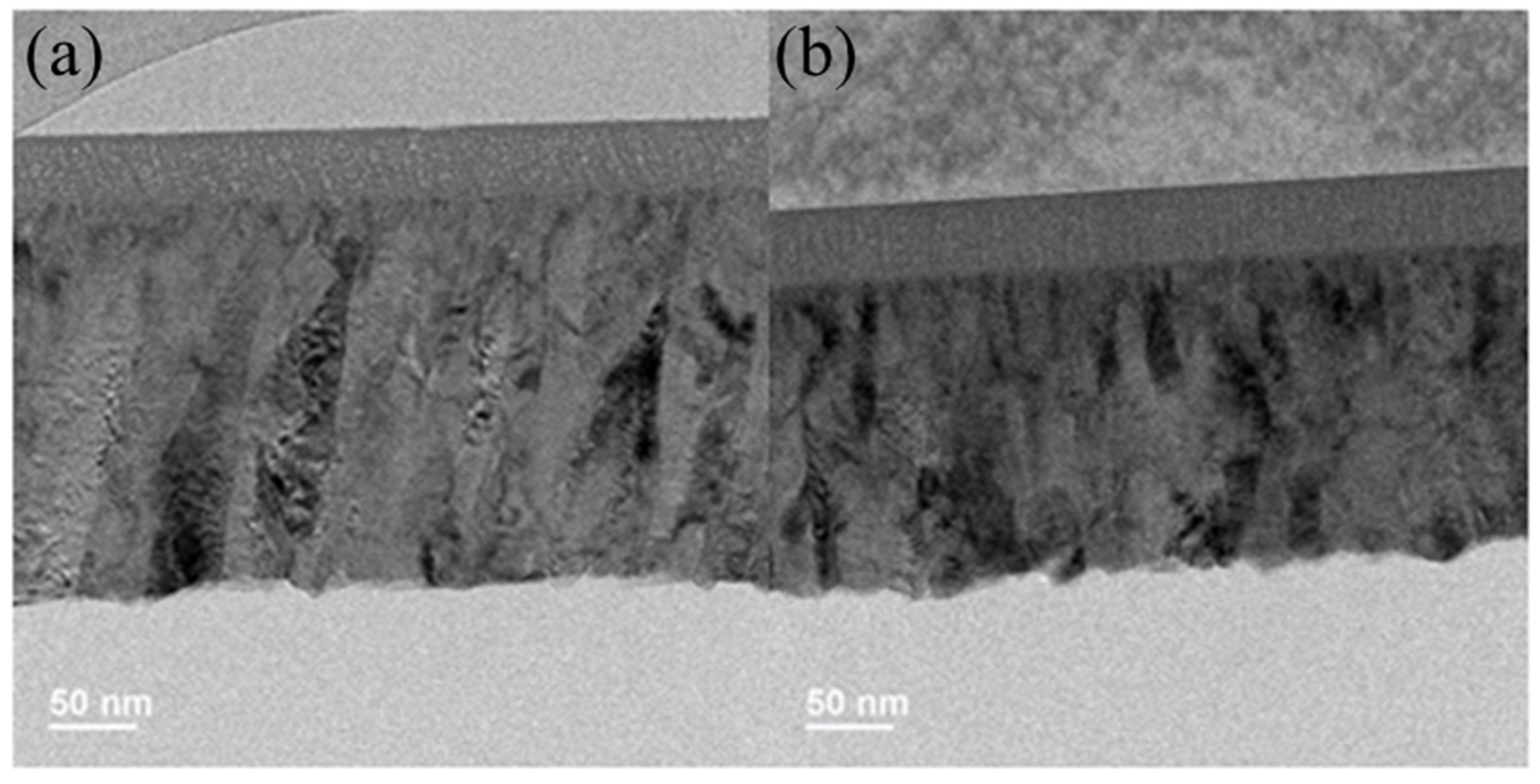

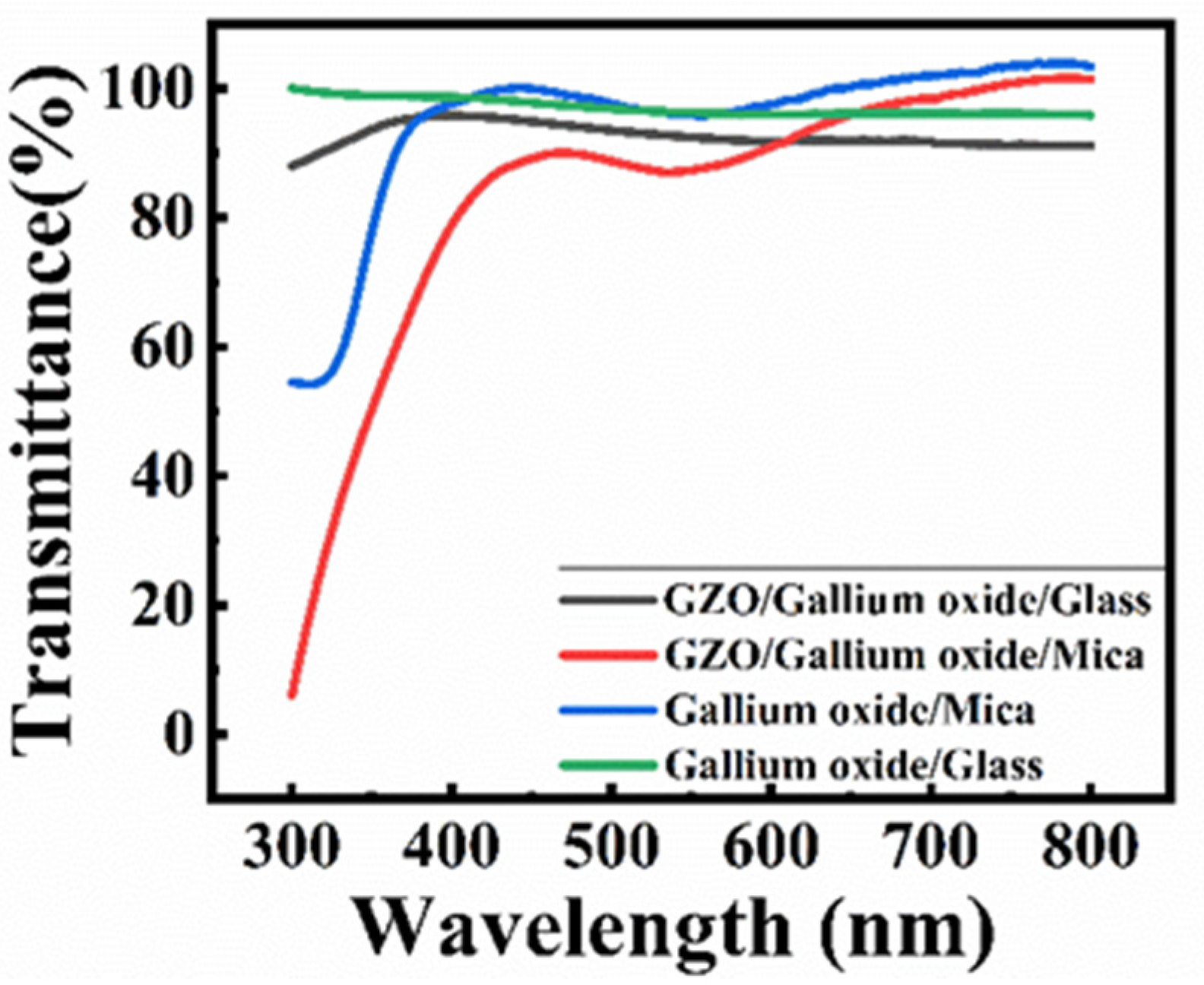
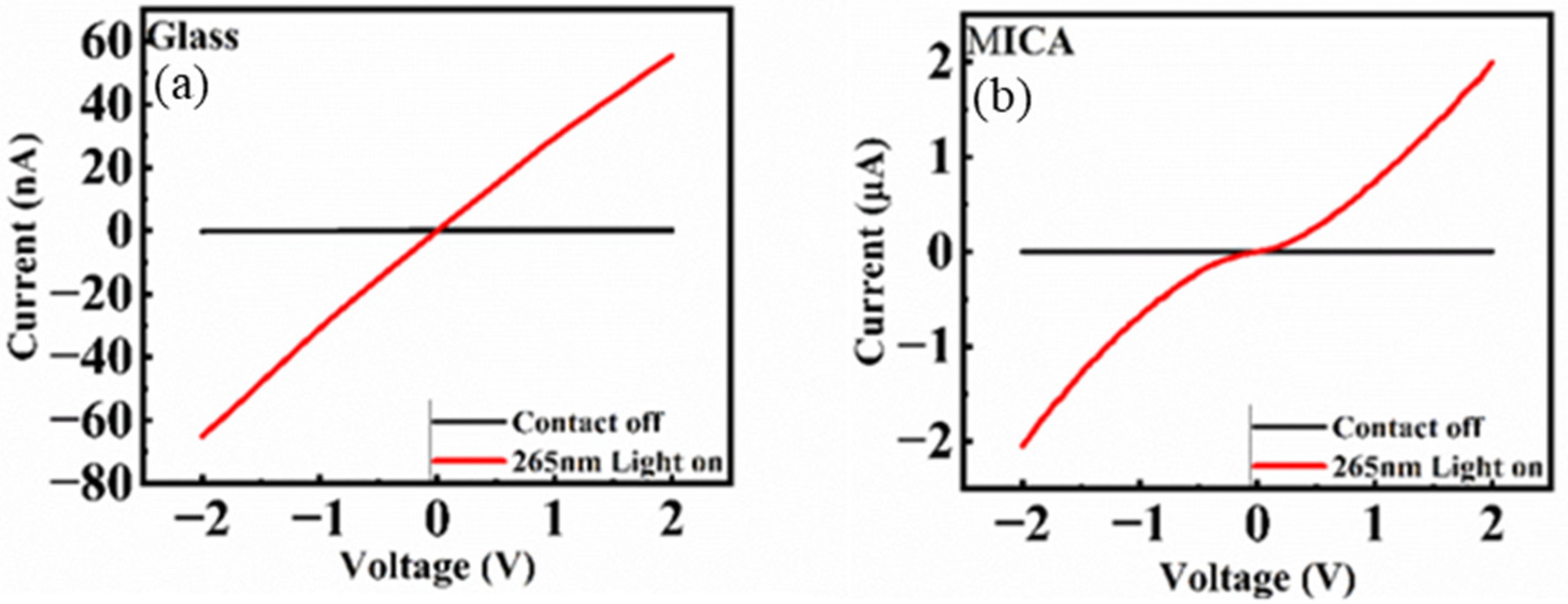
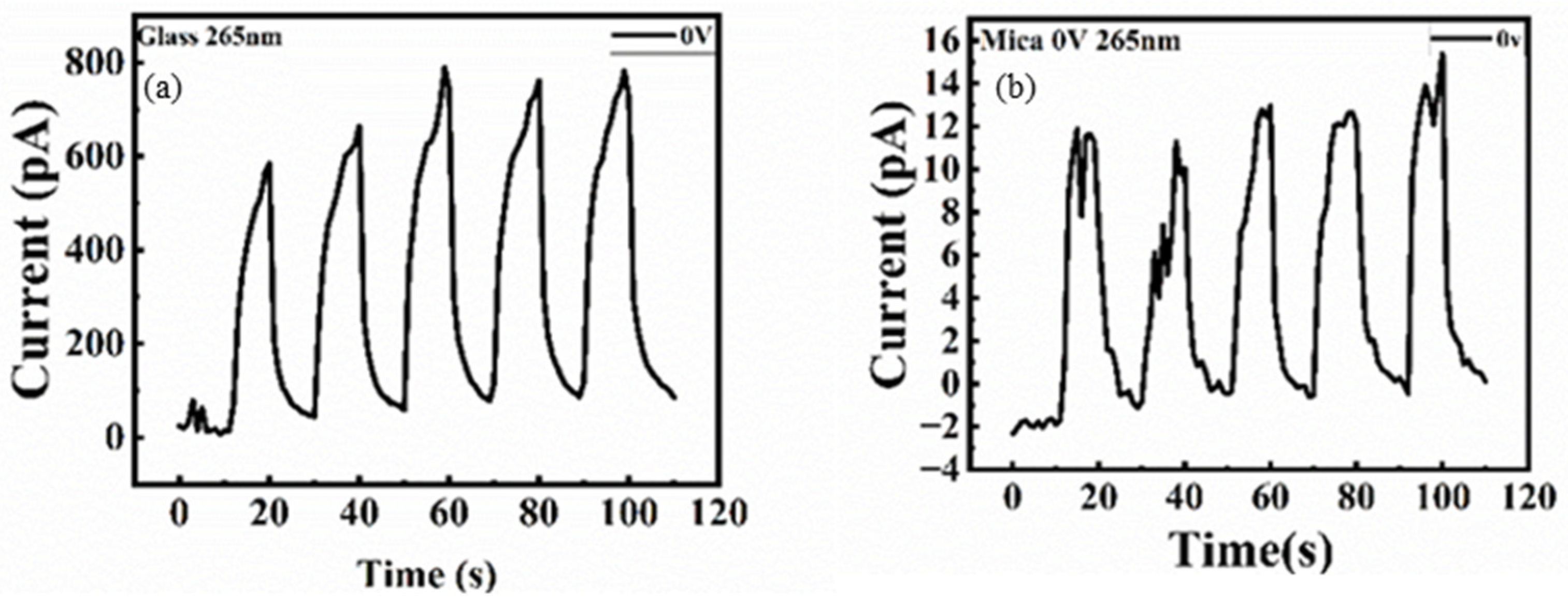


| Thin Film | Gas (sccm) | Power (W) | Pressure (mtorr) | Time (min) |
|---|---|---|---|---|
| GZO | 20 Argon | 60 | 2 | 30 |
| Gallium Oxide | 50 Argon | 90 | 5 | 45 |
| Structure | GO Type | Voltage (V) | tr/tf (s) | Responsivity (A/W) | Detectivity (Jones) | Transmittance (%) | Reference |
|---|---|---|---|---|---|---|---|
| GZO/GO/mica | polycrystalline | 0 | 5.7/4.78 | 8.80 × 10−9 | 9.76 × 104 | >80 | This work |
| GZO/GO/glass | polycrystalline | 0 | 6.72/4.7 | 4.42 × 10−7 | 6.14 × 105 | >90 | This work |
| GZO/Go/mica | polycrystalline | 1 | 7/4 | 8.84 × 10−5 | 7.89 × 106 | >80 | This work |
| GZO/GO/glass | polycrystalline | 1 | 1/2.4 | 1.08 × 10−2 | 1.81 × 108 | >90 | This work |
| Graphene/β-GO/ | β | 10 | - | 29.8 | 1.45 × 1012 | High | [12] |
| Graphene/PET | Amorphous | 10 | 1.73/3.4 | 16.34 | 1.19 × 1013 | >90 (without electrode) | [13] |
| Carbon/GO/carbon/Al2O3 | Amorphous | 10 | 1.73/3.4 | 16.34 | 1.19 × 1013 | >90 (without electrode) | [13] |
| Au/Graphene/β-Ga2O3/si/in | β | 0 | <30 ns/<2.24 μs | 1.03 × 10−2 | - | - | [14] |
| ITO/GO/ITO (array) | ε | 10 | 5.6 ms/7.2 ms | 286.2 | 4.73 × 1014 | Fully Transparent | [15] |
| ITO/α-Goβ-Ga2O3/ITO | Amorphous/β | 10 | - | 74.9 | 7.4 × 1015 | Fully Transparent | [16] |
| Ni/Au/κ-Ga2O3/ | κ- | 20 | 0.81/0.14 | 703 | 4.08 × 1014 | High | [17] |
Disclaimer/Publisher’s Note: The statements, opinions and data contained in all publications are solely those of the individual author(s) and contributor(s) and not of MDPI and/or the editor(s). MDPI and/or the editor(s) disclaim responsibility for any injury to people or property resulting from any ideas, methods, instructions or products referred to in the content. |
© 2025 by the authors. Licensee MDPI, Basel, Switzerland. This article is an open access article distributed under the terms and conditions of the Creative Commons Attribution (CC BY) license (https://creativecommons.org/licenses/by/4.0/).
Share and Cite
Wang, L.-W.; Wu, T.-Y.; Chu, S.-Y. Fabrications of Fully Transparent Gallium Oxide Solar-Blind Photodetectors. Nanomaterials 2025, 15, 1614. https://doi.org/10.3390/nano15211614
Wang L-W, Wu T-Y, Chu S-Y. Fabrications of Fully Transparent Gallium Oxide Solar-Blind Photodetectors. Nanomaterials. 2025; 15(21):1614. https://doi.org/10.3390/nano15211614
Chicago/Turabian StyleWang, Li-Wen, Tai-Yu Wu, and Sheng-Yuan Chu. 2025. "Fabrications of Fully Transparent Gallium Oxide Solar-Blind Photodetectors" Nanomaterials 15, no. 21: 1614. https://doi.org/10.3390/nano15211614
APA StyleWang, L.-W., Wu, T.-Y., & Chu, S.-Y. (2025). Fabrications of Fully Transparent Gallium Oxide Solar-Blind Photodetectors. Nanomaterials, 15(21), 1614. https://doi.org/10.3390/nano15211614






